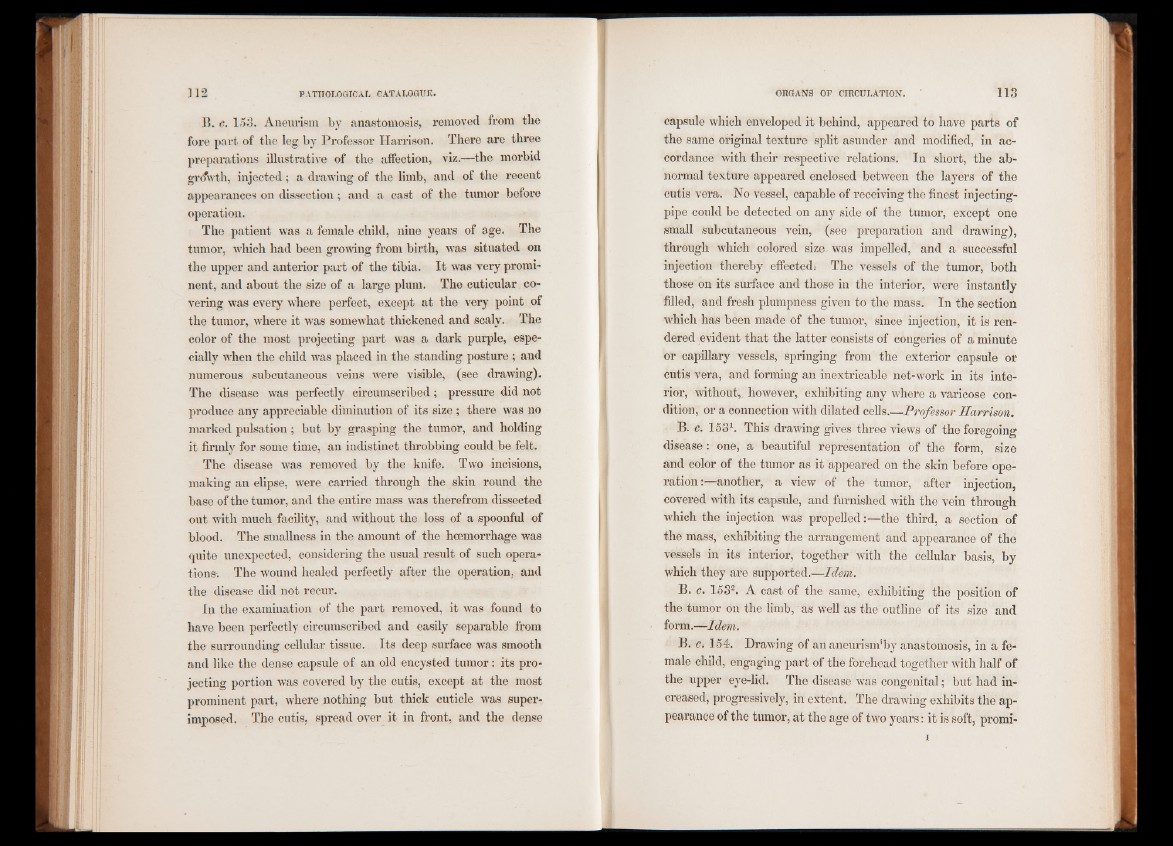
B. c. 153. Aneurism by anastomosis, removed from the
fore pai't of the leg by Professor Harrison. There are three
preparations illustrative of the affection, viz.—the morbid
grcfwth, injected; a drawing of the limb, and of the recent
appearances on dissection; and a cast of the tumor before
operation.
The patient was a female child, nine years of age. The
tumor, which had been growing from birth, wras situated on
the upper and anterior part of the tibia. It was very prominent,
and about the size of a large plum. The cuticular covering
was every where perfect, except at the very point of
the tumor, where it was somewhat thickened and scaly. The
color of the most projecting part was a dark purple, especially
when the child was placed in the standing posture ; and
numerous subcutaneous veins were visible, (see drawing).
The disease was perfectly circumscribed; pressure did not
produce any appreciable diminution of its size ; there was no
marked pulsation; but by grasping the tumor, and holding
it firmly for some time, an indistinct throbbing could be felt.
The disease wras removed by the knife. Two incisions,
making an elipse, were carried through the skin round the
base of the tumor, and the entire mass was therefrom dissected
out with much facility, and without the loss of a spoonful of
blood. The smallness in the amount of the haemorrhage was
quite unexpected, considering the usual result of such operations;
The wound healed perfectly after the operation, and
the disease did not recur.
In the examination of the part removed, it was found to
have been perfectly circumscribed and easily separable from
the surrounding cellular tissue. Its deep surface was smooth
and like the dense capsule of an old encysted tumor: its projecting
portion was covered by the cutis, except at the most
prominent part, where nothing but thick cuticle was superimposed.
The cutis, spread over it in front, and the dense
capsule which enveloped it behind, appeared to have parts of
the same original texture split asunder and modified, in accordance
with their respective relations. In short, the abnormal
texture appeared enclosed between the layers of the
cutis vera. No vessel, capable of receiving the finest injecting-
pipe could be detected on any side of the tumor, except one
small subcutaneous vein, (see preparation and drawing),
through which colored size was impelled, and a successful
injection thereby effected.- The vessels of the tumor, both
those on its surface and those in the interior, were instantly
filled, and fresh plumpness given to the mass. In the section
which has been made of the tumor, since injection, it is rendered
evident that the latter consists of congeries of a minute
or capillary vessels, springing from the exterior capsule or
cutis vera, and forming an inextricable net-work in its interior,
without,, however, exhibiting any where a varicose condition,
or a connection with dilated cells.—Professor Harrison.
B. c. 15S1. This drawing gives three views of the foregoing
disease : one, a beautiful representation of the form, size
and color of the tumor as it appeared on the skin before operationanother,
a view of the tumor, after injection,
covered with its capsule, and furnished with the vein through
which the injection was propelled:—the third, a section of
the mass, exhibiting the arrangement and appearance of the
vessels in its interior, together with the cellular basis, by
which they are supported.—Idem.
B. c. 1532. A cast of the same, exhibiting the position of
the tumor on the limb, as well as the outline of its size and
form.—Idem.
B. c. 154. Drawing of an aneurism'by anastomosis, in a female
child, engaging part of the forehead together with half of
the upper eye-lid. The disease was congenital; but had increased,
progressively, in extent. The drawing exhibits the appearance
of the tumor, at the age of two years: it is soft, promi